
I wanted to add some simple solar capabilities to the homestead to augment our little gasoline generator as a hedge against power outages. To be practical, a solar setup requires at least one battery. That pushed me into making up a portable battery bank.
Aside from providing a place to store my sun-gathered power, a battery bank can double as an alternate electrical source. This is not a new idea, of course.
Already Commercially Available
There are several companies out there that sell spiffy-looking all-in-one power units. They typically contain a big battery, a smart charger, and an inverter so you can run AC items. I like the looks of those units but not so much the costs.
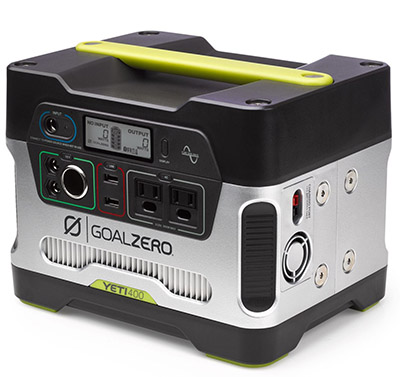
The Goal Zero Yeti 400, for instance, is built around a 33 Amp-hour lead-acid battery but sells for $450. It weighs 29 pounds. The Yeti 1000 has a 96 Amp-hour battery, costs $1,000 and weighs in at 105 pounds.
Enter DIY
Since I like making things myself (and I like to save money), I decided to build my own portable battery bank unit. I knew that my DIY project would not look nearly as spiffy as the commercial units but I was okay with that. Actually, I was not aiming for spiff. Functional, portable, and less-expensive were my design goals.

I bought two deep-cycle 12 volt, 35 Amp-hour batteries at $67 each. They can be a little cheaper now if you look around. It is important that multiple batteries match in size and ratings.
To make my battery bank portable, I needed a box to put both batteries in. Stanley sells a black plastic toolbox that was just the right size for my two batteries and a little bit of room left for cushioning the batteries.
.
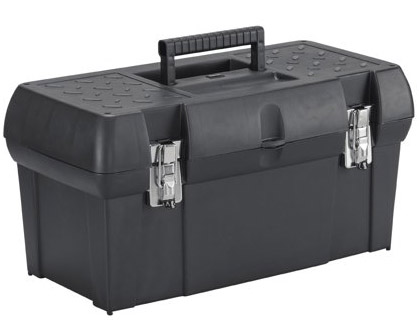
Given the weight of both batteries, (around 50 pounds together) the single plastic handle on the toolbox lid would not suffice. I bought two folding chest handles to put on the sides of the toolbox. They have been just right for moving my battery bank around. I used scrap polyethylene foam from shipping cartons to make spacers to keep the batteries in place. Salvaged nuts, bolts, and wire were used too.
.

Some of my pre-existing 12v accessories have an automotive cigarette lighter plug so I bought a socket kit from Amazon to wire into my box, making it a plug-and-play power source.
The charge controller that came with the solar kit fits neatly on top of one of the batteries. The controller manages current from the panels, preventing overcharging. The controller also has two USB ports for charging up electronics. It has two other sockets for plugging in a pair of LED lamps. Each is roughly equivalent to a 40 watt incandescent bulb. That is plenty bright for lighting up a room during an outage.
Already Owned
Prior to the battery bank, I already had a small (120 watt) inverter that I use to power my chainsaw sharpener in the field. That inverter has a cigarette lighter plug. I use that inverter, too, on long car trips to keep the laptop charged. I decided not to build this inverter into the box because I still like having it loose to use in the car or truck.
I am going to get a 1000 watt inverter soon, which will be enough to run my little microwave. You can do a lot with a microwave.
Cost For the Build?
Two 35 Amp-hour batteries cost me $67 each. $136 for batteries. (Amazon)
The Stanley toolbox was $15 (Home Depot)
The 12v socket kit was $10 (Amazon)
The chest handles were $6 (Amazon)
That makes a total of $167 for the battery bank.
If you don’t already have a small inverter, you can get a 150-watt inverter for under $20.
Solar — Harbor Freight’s 100-watt solar kit cost me $157 with shipping. It came with the 100-watt charge controller. Add the solar kit’s cost to my battery bank and the total solar/battery project cost me $324.
Compare that to the Yeti 400 with a
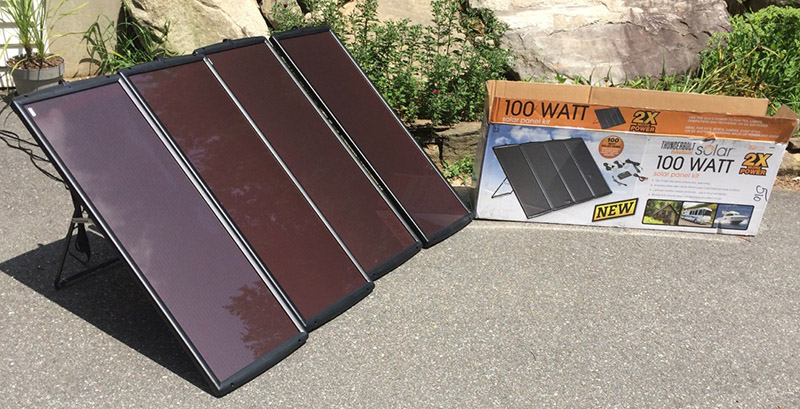
The solar panels give me the option to charge my battery bank indefinitely without the grid. I realize that 35 Amp-hours is not a lot. I don’t plan on powering my whole house (fridge, dishwasher, TV, furnace, etc.). They are emergency power for a few perks.
I explore the solar side of this project in a later post: Beyond the Generator: Small-scale Solar.
What Can I Power With My Battery Bank?
Phone Charging — We should be able to recharge our phones dozens of times over. Or, forever, thanks to solar.
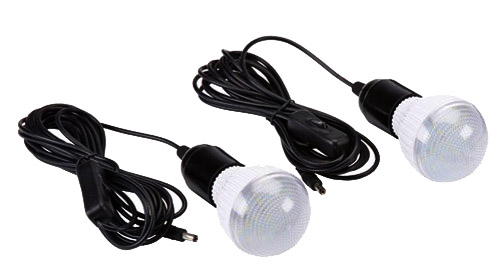
Lighting — The Harbor Freight solar kit came with two LED lights that are quite bright, should we need light but not want to use our oil lamps.
Power Tools — The 120-watt inverter can drive my power tools’ battery charger. This means I can use some power tools (drill, angle grinder-cutter, an 8” chainsaw, etc.) even if the grid is down.
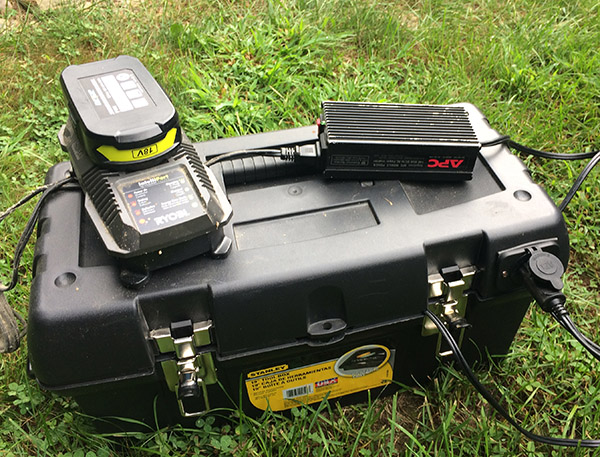
I won’t be undertaking any serious construction projects or felling trees with battery power but I will be able to make repairs faster and cut up rocket stove fuel faster.
Laptop Charging — I can power my laptop’s 65-watt power brick. Granted, in a grid-down scenario, there won’t be
.
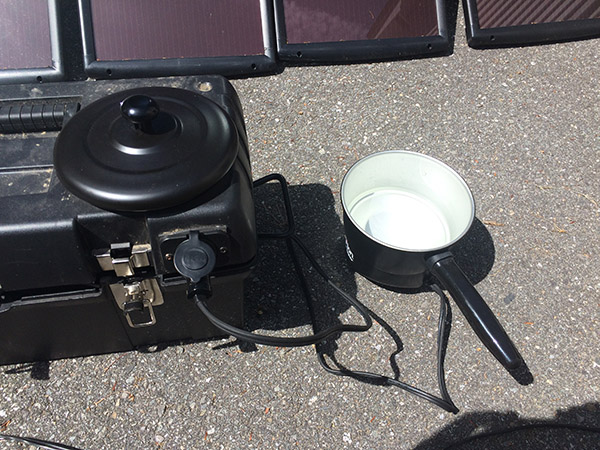
Cooking — My 12v saucepan (a trucker item) lets me boil water to make coffee, oatmeal, and reconstitute dehydrated meals from our emergency food stash. I’ve boiled plain rice in it too. The 12v pot is a way to prepare hot meals without fire or fuel.
Freezing — My 7 cu-ft chest freezer uses 100 watts so my 120w inverter can power that too. No more worries that a power outage will spoil my frozen food. That little chest unit freezes things rock hard, too. I could use it to make ice to keep my refrigerator cool as well, rather than running my 800-watt fridge off the generator.
Security — I have some wireless “driveway alarm” sensors that I use to detect varmint activity on the ‘dark side’ of the chicken coop. Each sensor itself runs on a 9v battery. The base unit uses 12 volts and draws about 10 watts. I could deploy more sensors as perimeter alarms around the property, using my battery bank to drive the base unit during the night. Grid-down security alarm!

Grid power via a “float” charger keeps the battery bank charged while there’s a grid.
If there was no grid power, the solar cells provide the recharging power.
Length Of Service?
While I can do any of the things listed above, my batteries can only go so far. How long could I run my freezer or cook with my little sauce pan? That takes some calculating.
They say that deep cycle batteries give the best service life if allowed to drain down to only half-power before recharging. They can be drained more and charged back up, but doing so shortens their life. Longest battery life comes from usage down to no more than 50% capacity and then recharging. With that in mind…
Number Crunching — Since I have two 35 Amp-hour batteries, half power is easy to figure: 35 Amp-hours. 35 Amp-hours times 12 volts equals 420 watt-hours. That would be 420 watts of consumption for one hour, or 210 watts of use for 2 hours, etc.
Practically applied, I could run my 150-watt saucepan for a little over two hours, or I could run my 100-watt freezer for four hours. I could run one of the 5-watt LED lamps for over 250 hours. I could totally recharge my laptop twice. When I get my 1000-watt inverter, I could run my 700-watt microwave oven for 35 minutes. That doesn’t sound like all that much, but you can cook a lot with 35 minutes of microwave time.
Solar Replenishment
420 watt-hours is a manageable amount for a day’s recharge with 100-watt solar panels. The idealized routine would be to use no more than 420 watts during the evening, then replenish the 420 watts the next day. That is a sustainable regimen.
Stewardship Caveats — Solar panels do not always produce their rated power. (Seldom, actually) Much depends on the angle to the sun, intensity, clouds, etc. Under ideal conditions, it would take 4.2 hours of charging to put back the 420 watts. More realistically, it takes 6 to 8 hours of sunlight to replace the 420 watts. For most days, that’s not a problem. In the middle of winter (short days), or a string of cloudy days, there would be less recharge available. Some days won’t have 420 watts of sun.
In a prolonged grid-down situation, I would be moving my panels around each day to harvest optimal sun in order to assure getting the 420 watt-hours of power back in my batteries. Power frugality comes into play. If I can avoid using up all 420 watt-hours allotment in an evening, I won’t need to harvest as much the next day.
Non-Solar Uses? You bet
A battery backup box is handy to have, even without solar panels.
Stay-Dry — For me, it gives me a way to not get soaked if the power goes out during a raging storm. We keep the generator in the shed (with the gasoline) away from the house. Instead of setting up the generator (which must be outside to run, of course) in the wind and rain, or ice and snow, I can use my battery bank (stored in the attached garage) to power some things and wait for the storm to pass before deploying my generator.
Small Doses — One thing about generators is that they are Full On, or nothing. A 2000-watt generator is burning fuel to crank out 2000 watts whether you’re using them or not. (Yes, I know full-load consumption is more than no-load but you know what I mean.) That’s fine if I have 2000 watts of stuff to power at once: the fridge, freezer, etc. Then, it’s worth cranking up the generator for a half-hour stint to use those 2000 watts strategically.
The battery bank allows me to power smaller things without having to crank up the generator and burn gasoline just to charge my laptop.
Silence — In an SHTF application, the battery bank would provide power when I won’t want the noise of the generator attracting attention.
Taking a cue from one of Steven Harris’s videos about battery banks, I bought a small plug-in charger ($40 from Amazon). The little charger has a “float” feature that keeps the batteries safely at full charge (13.3v). Batteries self-discharge over time so they need topped up regularly. Left plugged in and attached to the batteries, the little charger keeps my battery bank topped up and ready. If you were going totally off-grid you would not need a plug-in float charger. The solar panels’ charge controller would tend to that. I added it to keep my batteries ready-to-go while there is a grid without having to get out my solar panels every day.
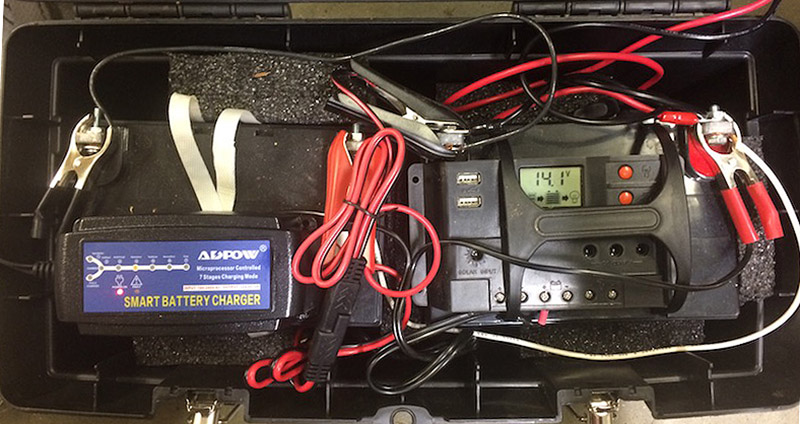
Diversification and Redundancy
My little battery bank is a preparedness diversification rather than a primary backup for anything critical. We have the wood stove for heat and cooking in winter. We have the propane grill for cooking in the summer and a cinderblock ‘rocket stove’ as a wood-fired alternative to the grill. Water comes from a hand pump on the well or the rain barrels. Sewage is by a septic system. We have oil lamps for emergency lighting. The major needs already have non-electric alternatives.
The battery box gives me some voltage for things not power-able by wood or by hand. It gives me redundancy in lighting. The solar kit’s LED lights alone could replace our oil lamp use. The battery bank could easily recharge our flashlight batteries for portable light. The battery bank lets me run my little freezer temporarily during an outage. Solar panels let me do all these things indefinitely.
Bottom line?
While I really like the sleek looks of units like Goal Zero’s Yeti line, I also like being able to build something functionally akin to it myself for under half the cost. Nothing about my build required anything above handyman skill or tools.
Heck, if I can do it, you can build a battery bank too. You could even add some small-scale solar as phase 2! Maybe a battery bank for your home or apartment would be a good preparedness project for the winter. What do you think?
——

Solution is great for everything “short of” an EMP event. 😉
Mic actually this was the article that brought me to your site! In reply to the “short of an EMP” event comment.
A lot is not well known about EMP or CME events but it seems to be accepted that if an item is plugged into the Grid the antenna effect of those power lines all over America will fry it with a surge of power. Some reports from the former USSR’s EMP studies shows fires being caused by that overload so be aware. Unlikely the Fire Department will be responding during SHTF. I have plenty of fire extinguishers around the household for that reason. Small non computer chip electronics not plugged into the grid seem to resist it well like battery drills, DC pumps and such.
Back to the battery bank Solar recharge system. 420 watts is not a lot I agree but look at all it can do for you. Things our 1800’s pioneers would be delighted to have. A floor box fan to help cool you or spread a wood stove heat is less than 80 watt per hour at medium setting. That same fan could be used to help process grains when your separating wheat from chaff using a screen box and a breeze or assisting your solar dehydrator to dry foods for winter.
While you COULD use a 12 volt 150 watt hour sauce pan maybe a Concrete block Rocket stove or a #10 can rocket stove would be more useful? In NH tree limb droppings are everywhere to feed it.
Light, what would the 1800 pioneers think about having Fire Safe Lighting? Many a pioneer home or barn was lost to candles, oil lanterns etc. Again no Fire Department post SHTF.
Water pumping! At 8 pounds a gallon that 12 volt sure flow water pump (a good RV pump) seems a real deal in moving 100’s of gallons for hours with hoses or PVC piping to spread the joy.
In the 1800’s they used a Yoke to carry two buckets of water at a time. Kind of hard to do a drip irrigation system or run a solar heated shower that way.
POWER Management. While your safe 2 battery draw down @50% is 420 watts please remember even if your batteries are full those solar panels in full sunshine are still creating power. For example if your batteries are full and your using that sure flow water pump your taking otherwise wasted solar power and getting a lot of heavy lifting done.
I’m not a big fan of Harbor Freight products, some work very well forever, some don’t but they are a good first step, learning tool to learn about Solar power.
Solar power is almost plug and play. A good quality 400 watt solar kit with out batteries or inverter runs around 500-600 dollars today. 4 deep cycle batteries would give you closer to 840 watts of safe battery power. In NH I find on a sunny day a 400 watt array can refill that 50% depleted battery bank in about 3 hours. Thus with smart power management much like the Gasoline Hit and Miss motors of old farms you can get a lot done, one task at a time. I used to vacuum my house when the batteries were full.
EMP or simply a grid down situation can thrust us into the 1800’s lifestyle. I plan on retaining as much of the 20th century as I can. Faraday cages are not hard to do, especially given my NEED to listen in after a grid down (EMP or…) event to see if it’s LOCAL, State Wide or truly SHTF. A good AM-FM-SW radio stored in the Faraday cage with batteries stored separately is cheap and allows you to listen in to even Europe for information. If you have allies having a CB set up stored could be life changing or at least give folks trying to get to your home a way to communicate with you. 400 watts could be awesome.
Sorry for double post tonight but I forgot what I think of as most important solar power advantage. The ability to power a seed starting heating pad and LED grow lights.
While shelter is important, water is critical as well as FOOD. Having a little Solar power allows you to start successive batches of garden plants as well as winter production of cold tolerant plants like Bok Choy and such.
If you have ever started your own seeds into starts for transplant you’d know how wonderful having a Soil Block maker (to provide home made “peat style pots”) a seedling warming pad and grow lights can be.
Merry Christmas to you and yours. Maybe a Christmas gift this year maybe for gardening-preparedness?
Glad to read your blog, Mic Roland! Thanks for an amazing article about DIY Battery Bank: How to & Uses. I am happy that you shared such a helpful and amazing blog for us. Keep posting articles stay connected and get back soon with a new knowledgeable and interesting article.